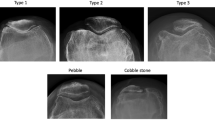Abstract
Objective
To review the MRI appearance of medial patellofemoral capsuloligamentous plication (also known as reefing or imbrication) for proximal patellar realignment in patients with patellofemoral instability.
Materials and methods
Retrospective analysis of our surgical and PACS databases identified cases of medial plication performed between June 2011 and July 2016. Pre- and postoperative MRI characteristics were reviewed. Correlation was made with operative reports and clinical records to define postoperative appearances on MRI.
Results
Forty-one patients underwent medial plication during the study period; 29 were excluded owing to a lack of postoperative imaging. Ultimately, 12 knees were included in 11 patients who had postoperative MRI studies available (8 women and 3 men, mean age 27.3 ± 10.2 years). Ten (83%) of the surgeries were performed open and 2 (17%) arthroscopically. There were differences in the post-surgical MRI appearance of medial plications carried out after surgery using the open and arthroscopic techniques. The open technique produces a “heaped up” distal vastus medialis obliquus (VMO) with centralized patellar insertion (100%), which was absent in the case of arthroscopic plication, where subtle medial retinaculum thickening was demonstrated without alteration of its patellar insertion. The mean postoperative lateral patellar and patellofemoral congruence angles measured 2.5° ± 5.6° and 12.4° ± 19.9° respectively. A significant association was found regarding change in patellofemoral alignment (p = 0.018 and p = 0.004 respectively).
Conclusion
The MRI appearance of medial plication is not well described in the radiology literature; radiologists should be familiar with anticipated post-plication findings to avoid potential confusion for pathology and allow more accurate interpretation of postoperative imaging findings from this common surgery.




Similar content being viewed by others
References
Duchman KR, Bollier MJ. The role of medial patellofemoral ligament repair and imbrication. Am J Orthop (Belle Mead NJ). 2017;46(2):87–91.
Diederichs G, Issever AS, Scheffler S. MR imaging of patellar instability: injury patterns and assessment of risk factors. Radiographics. 2010;30(4):961–81.
Xu H, Zhang C, Pei G, Zhu Q, Han Y. Arthroscopic medial retinacular imbrication for the treatment of recurrent patellar instability: a simple and all-inside technique. Orthopedics. 2011;34(7):524–9.
Shelbourne KD, Urch SE, Gray T. Results of medial retinacular imbrication in patients with unilateral patellar dislocation. J Knee Surg. 2012;25(5):391–6.
Mehl J, Feucht MJ, Bode G, Dovi-Akue D, Sudkamp NP, Niemeyer P. Association between patellar cartilage defects and patellofemoral geometry: a matched-pair MRI comparison of patients with and without isolated patellar cartilage defects. Knee Surg Sports Traumatol Arthrosc. 2016;24(3):838–46.
Laprade J, Culham E. Radiographic measures in subjects who are asymptomatic and subjects with patellofemoral pain syndrome. Clin Orthop Relat Res. 2003;414:172–82.
Koskinen SK, Taimela S, Nelimarkka O, Komu M, Kujala UM. Magnetic resonance imaging of patellofemoral relationships. Skeletal Radiol. 1993;22(6):403–10.
Bencardino JT, Rosenberg ZS, Brown RR, Hassankhani A, Lustrin ES, Beltran J. Traumatic musculotendinous injuries of the knee: diagnosis with MR imaging. Radiographics. 2000;20 Spec No:S103–20.
Nietosvaara Y, Paukku R, Palmu S, Donell ST. Acute patellar dislocation in children and adolescents. Surgical technique. J Bone Joint Surg Am. 2009;91(Suppl 2 Pt 1):139–45.
Reagan J, Kullar R, Burks R. MPFL reconstruction: technique and results. Clin Sports Med. 2014;33(3):501–16.
Vasso M, Corona K, Toro G, Rossini M, Schiavone PA. Anatomic double-bundle medial patellofemoral ligament reconstruction with autologous semitendinosus: aperture fixation both at the femur and the patella. Joints. 2017;5(4):256–60.
Lobner S, Krauss C, Reichwein F, Patzer T, Nebelung W, Venjakob AJ. Surgical treatment of patellar instability: clinical and radiological outcome after medial patellofemoral ligament reconstruction and tibial tuberosity medialisation. Arch Orthop Trauma Surg. 2017;137(8):1087–95.
Shah JN, Howard JS, Flanigan DC, Brophy RH, Carey JL, Lattermann C. A systematic review of complications and failures associated with medial patellofemoral ligament reconstruction for recurrent patellar dislocation. Am J Sports Med. 2012;40(8):1916–23.
Author information
Authors and Affiliations
Corresponding author
Ethics declarations
Conflicts of interest
The authors declare that they have no conflicts of interest.
Rights and permissions
About this article
Cite this article
Walter, W.R., Pham, H., Meislin, R.J. et al. MRI findings associated with medial patellofemoral capsuloligamentous plication. Skeletal Radiol 47, 1229–1235 (2018). https://doi.org/10.1007/s00256-018-2916-6
Received:
Revised:
Accepted:
Published:
Issue Date:
DOI: https://doi.org/10.1007/s00256-018-2916-6




